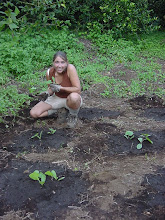Without further ado, allow me to introduce my garden's latest showstopper:
 The family Passiflora is large and varied, so identifying specific species is a bit out of my league. Passionflowers stand out with their dazzling bold blossoms, typically pollinated by large bees and hummingbirds (both of which I have seen buzzing by this very flower).
The family Passiflora is large and varied, so identifying specific species is a bit out of my league. Passionflowers stand out with their dazzling bold blossoms, typically pollinated by large bees and hummingbirds (both of which I have seen buzzing by this very flower). Passionflower of course produces passionfruit, a baseball-sized fruit that Nicas call calala, which is popular in juice. In the market they are sold a ripe yellow color, so as of yet, the calala in the photo is not mature.
Passionflower of course produces passionfruit, a baseball-sized fruit that Nicas call calala, which is popular in juice. In the market they are sold a ripe yellow color, so as of yet, the calala in the photo is not mature.I can take a pretty good stab at this, my second vine, being the largest of all passionflower varieties, Passiflora quadrangularis.
 Granadilla is a gigantic fruit, also containing a tart flesh used for refreshing drinks. It is especially large for growing on a vine, but sorry--I do not actually have any fruit on this guy yet.
Granadilla is a gigantic fruit, also containing a tart flesh used for refreshing drinks. It is especially large for growing on a vine, but sorry--I do not actually have any fruit on this guy yet.isn't this blossom enough???!
 The granadilla vine is part of my vision of a natural shade patio; an edible, ornamental, and also functional plant!
The granadilla vine is part of my vision of a natural shade patio; an edible, ornamental, and also functional plant! the flowers dangle straight down, as will the fruit
the flowers dangle straight down, as will the fruitFor now I am perfecting the art of passionfruit juice so that I'll be ready when my own crop is ripe ;)
Calalas contain dark colored seeds encased in a slimy pulp, which I know, does not look super tasty. but stay with me...
Calalas contain dark colored seeds encased in a slimy pulp, which I know, does not look super tasty. but stay with me...

In Nica it is common practice to serve fruit juices with their pulp and/or seeds, leaving you with gulps of chunky beverage to enjoy, or if you're like me, with a tricky "straining of your own glass without looking too gross" technique. Therefore, in making my own batch, I press the pulp through a strainer, extracting as much of the tangy flavor without the actual globs.

Add water in the straining process, about 1 cup per fruit, and sugar to taste.





6 comentarios:
Mmmm yum. Looks as though you are well on the way to harvesting bucketloads of passionfruit. I just love the smell of the flowers too. I love to add a bit of sweetener to that strained pulp, then store it in the fridge as a cordial and add soda water as needed.
I am so jealous! My passionfruit is still a bit on the small side since I started it from seed last fall. On the bright side, it survived our very cold winter somehow! I'll have to find another one soon so I can cross pollinate it.
Do you get the banana shaped ones as well? Delicioso!
Looks delicious and what an amazing plant. This is my first time to ever see a passion flower. Truly amazing!
we have this flower in Richmond! How? Curiouser and curiouser. LYLAS
Not surprisingly, squirrels like the flowers too (the nectar, I'm guessing). I was in the San Francisco Botanical Garden the other day and had a fun photo shoot of one crawling through Passiflora mollissima vines and chewing on the ends of the pink flowers. The gardeners there hate the squirrels, but I have to say it was pretty cute!
Publicar un comentario